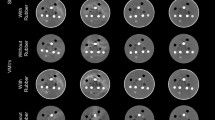Abstract
Purpose
To compare radiation dose and image quality for abdominal CTs performed on a spectral detector CT (SDCT) and a comparable single-energy conventional CT scanner for patients of different sizes.
Methods
Four semi-anthropomorphic phantoms were scanned on an SDCT (IQon, Philips Healthcare) and a comparable single-energy CT (iCT 256, Philips Healthcare) under matched scan parameters. Image noise and radiation dose were compared. For the HIPAA-compliant, IRB-approved retrospective cohort patient study, radiation dose was compared after adjusting for patient water equivalent diameter. Difference in subjective and objective image quality was assessed on a subset of 50 patients scanned on both scanners by two readers.
Results
CTDIvol and noise from SDCT were higher than conventional CT for all phantoms, with a relative difference of 7.8% (range 5.3–14%) for radiation dose and average difference of 9.0% (range 5.5–11%) for noise. 718 SDCT and 937 conventional CT patients were included in the patient study. CTDIvol for SDCT patients tends to be lower for smaller patients (− 2%, 95% confidence interval (− 5%, − 0.2%) for 200 mm water equivalent diameter) and higher for larger patients compared to conventional CT (8%, (6%, 11%) for 400 mm). No difference was seen for subjective image quality, SNR, CNR, or image noise between the two scanners, except for higher image noise in the portal vein and higher signal in the aorta on SDCT.
Conclusion
Radiation dose for abdominal CT performed on SDCT is similar to the dose on a conventional CT for average size patients, lower for smaller patients, and slightly higher for larger patients. Image quality is similar between the two scanners.






Similar content being viewed by others
References
Aran S, Daftari Besheli L, Karcaaltincaba M, Gupta R, Flores EJ, Abujudeh HH. Applications of dual-energy CT in emergency radiology. AJR Am J Roentgenol 2014; 202:W314-324
Mallinson PI, Coupal TM, McLaughlin PD, Nicolaou S, Munk PL, Ouellette HA. Dual-Energy CT for the Musculoskeletal System. Radiology 2016; 281:690-707
Potter CA, Sodickson AD. Dual-Energy CT in Emergency Neuroimaging: Added Value and Novel Applications. Radiographics 2016; 36:2186-2198
Vlahos I, Chung R, Nair A, Morgan R. Dual-energy CT: vascular applications. AJR Am J Roentgenol 2012; 199:S87-97
Ananthakrishnan L, Duan X, Rajiah P, et al. Phantom Validation of Spectral Detector Computed Tomography–Derived Virtual Monoenergetic, Virtual Noncontrast, and Iodine Quantification Images. Journal of computer assisted tomography 2018; 42:959-964
Duan X, Arbique G, Guild J, Xi Y, Anderson J. Technical Note: Quantitative accuracy evaluation for spectral images from a detector-based spectral CT scanner using an iodine phantom. Med Phys 2018; 45:2048-2053
Ho LM, Yoshizumi TT, Hurwitz LM, et al. Dual energy versus single energy MDCT: measurement of radiation dose using adult abdominal imaging protocols. Acad Radiol 2009; 16:1400-1407
Christner JA, Kofler JM, McCollough CH. Estimating effective dose for CT using dose-length product compared with using organ doses: consequences of adopting International Commission on Radiological Protection publication 103 or dual-energy scanning. AJR Am J Roentgenol 2010; 194:881-889
De Cecco CN, Darnell A, Macias N, et al. Second-generation dual-energy computed tomography of the abdomen: radiation dose comparison with 64- and 128-row single-energy acquisition. J Comput Assist Tomogr 2013; 37:543-546
Purysko AS, Primak AN, Baker ME, et al. Comparison of radiation dose and image quality from single-energy and dual-energy CT examinations in the same patients screened for hepatocellular carcinoma. Clin Radiol 2014; 69:e538-544
Wichmann JL, Hardie AD, Schoepf UJ, et al. Single- and dual-energy CT of the abdomen: comparison of radiation dose and image quality of 2nd and 3rd generation dual-source CT. Eur Radiol 2017; 27:642-650
Haneder S, Siedek F, Doerner J, et al. Thoracic-abdominal imaging with a novel dual-layer spectral detector CT: intra-individual comparison of image quality and radiation dose with 128-row single-energy acquisition. Acta Radiol 2018; 59:1458-1465
McCollough C, Bakalyar DM, Bostani M, et al. Use of Water Equivalent Diameter for Calculating Patient Size and Size-Specific Dose Estimates (SSDE) in CT: The Report of AAPM Task Group 220. AAPM Rep 2014; 2014:6-23
Foley WD, Shuman WP, Siegel MJ, et al. White Paper of the Society of Computed Body Tomography and Magnetic Resonance on Dual-Energy CT, Part 2: Radiation Dose and Iodine Sensitivity. J Comput Assist Tomogr 2016; 40:846-850
Patel BN, Alexander L, Allen B, et al. Dual-energy CT workflow: multi-institutional consensus on standardization of abdominopelvic MDCT protocols. Abdom Radiol (NY) 2017; 42:676-687
Atwi NE, Smith DL, Flores CD, et al. Dual-energy CT in the obese: a preliminary retrospective review to evaluate quality and feasibility of the single-source dual-detector implementation. Abdom Radiol (NY) 2019; 44:783-789
Rajiah P, Rong R, Martinez-Rios C, Rassouli N, Landeras L. Benefit and clinical significance of retrospectively obtained spectral data with a novel detector-based spectral computed tomography - Initial experiences and results. Clinical imaging 2017; 49:65-72
Haneder S, Siedek F, Doerner J, et al. Thoracic-abdominal imaging with a novel dual-layer spectral detector CT: intra-individual comparison of image quality and radiation dose with 128-row single-energy acquisition. Acta Radiologica 2018;
Ananthakrishnan L, Duan X, Rajiah P, et al. Phantom Validation of Spectral Detector CT derived Virtual Monoenergetic, Virtual Non-Contrast, and Iodine Quantification Images. Journal of computer assisted tomography 2018;
Hojjati M, Van Hedent S, Rassouli N, et al. Quality of routine diagnostic abdominal images generated from a novel detector-based spectral CT scanner: a technical report on a phantom and clinical study. Abdom Radiol (NY) 2017;
Author information
Authors and Affiliations
Corresponding author
Additional information
Publisher's Note
Springer Nature remains neutral with regard to jurisdictional claims in published maps and institutional affiliations.
Rights and permissions
About this article
Cite this article
Duan, X., Ananthakrishnan, L., Guild, J.B. et al. Radiation doses and image quality of abdominal CT scans at different patient sizes using spectral detector CT scanner: a phantom and clinical study. Abdom Radiol 45, 3361–3368 (2020). https://doi.org/10.1007/s00261-019-02247-1
Published:
Issue Date:
DOI: https://doi.org/10.1007/s00261-019-02247-1




